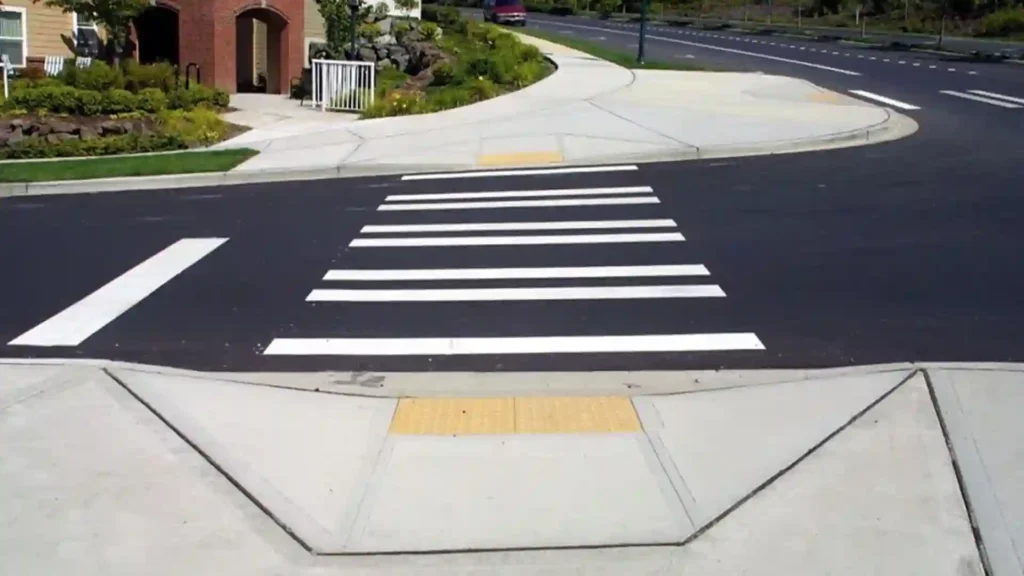Looking to install or repair a commercial sidewalk in Charlotte? Hiring the right concrete sidewalk contractor is essential to ensure your walkways meet ADA accessibility standards, protect pedestrians, and avoid costly compliance issues. From selecting slip-resistant surfaces to planning proper drainage, curb ramps, and lighting, every detail matters for safety and long-term durability.
This guide walks business owners and property managers through ADA-compliant sidewalk planning, material choices, installation tips, and local code considerations—showing how expert contractors combine craftsmanship with compliance to create safe, lasting walkways.
Key ADA Compliance Requirements for Commercial Sidewalks in Charlotte
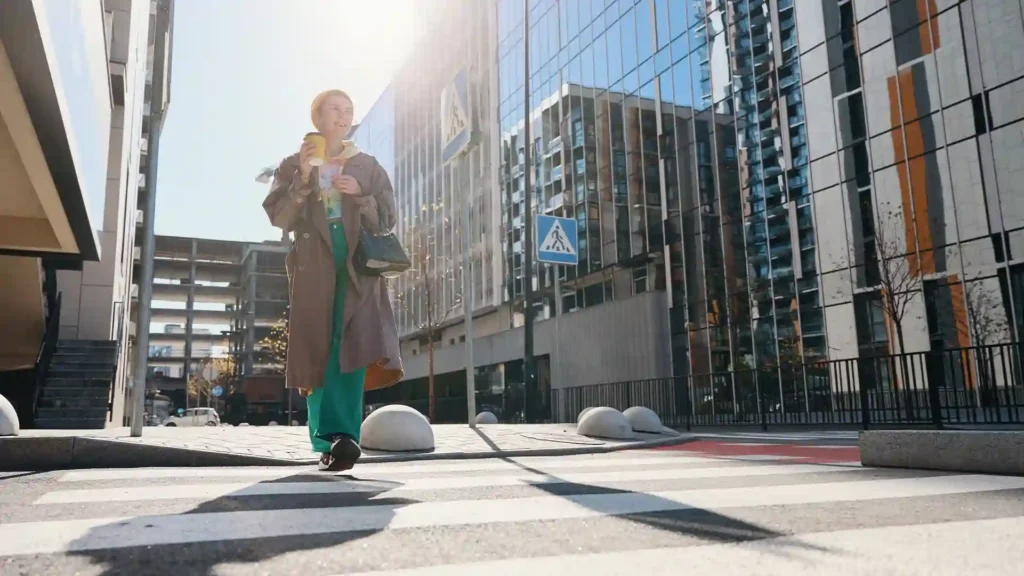
Ensuring ADA compliance isn’t just about following regulations, it’s about creating safe, accessible, and durable walkways for all pedestrians. According to ADA.gov, critical elements that sidewalk contractors and general contractors focus on include:
- Minimum clear width for pedestrian access
- Maximum running and cross slopes
- Properly designed curb ramps
- Detectable warning surfaces at transitions
Meeting these standards reduces legal risk, prevents costly repairs, and improves pedestrian flow. Properly designed sidewalks also enhance adjacent driveways by managing water runoff and reducing vehicle-pedestrian conflicts.
Durafy Pro Tip: Engage your general contractor and sidewalk contractors early on any necessary slope, drainage, and curb ramp locations to avoid costly change orders after concrete is poured.
What is the Standard ADA Sidewalk Width?
The minimum clear width of an ADA sidewalk is 36 inches between any vertical guardrails, ensuring wheelchairs, scooters or other mobility devices can safely move through. By ADA standards, it is also wide enough for two people to walk through side by side and can accommodate busy commercial spaces.
Durafy Pro Tip: Where sidewalks meet driveways, provide extra width or islanding zone for additional safety for pedestrians against turning vehicles.
Sidewalk Feature | ADA Requirement | Why It Matters |
Clear Width | ≥36 inches | Wheelchair and pedestrian access |
Running Slope | ≤5% (1:20) | Prevents wheelchair drift |
Cross Slope | ≤2% (1:50) | Directs water off walkway |
Curb Ramp Slope | ≤8.33% (1:12) | Safe street transition |
Detectable Warning | 24-inch deep domes | Alerts visually impaired users |
Maximum Slope Guidelines
For level walking surfaces, ADA standards dictate a maximum slope of 5% (4.8 degrees) and for cross slope of 2%, according to the ADA Standards for Accessible Design. These slope limits:
- Keep wheelchairs stable on inclines
- Eliminate slip and trip hazards in damp conditions
- Guide surface water to drain away on slopes, saving sidewalks and driveways
Durafy Pro Tip: Curb ramps need to have a smooth transition from sidewalk to driveway. Professional sidewalk contractors can also deliver nice grades without violating ADA requirements.
ADA Curb Ramp Specifications
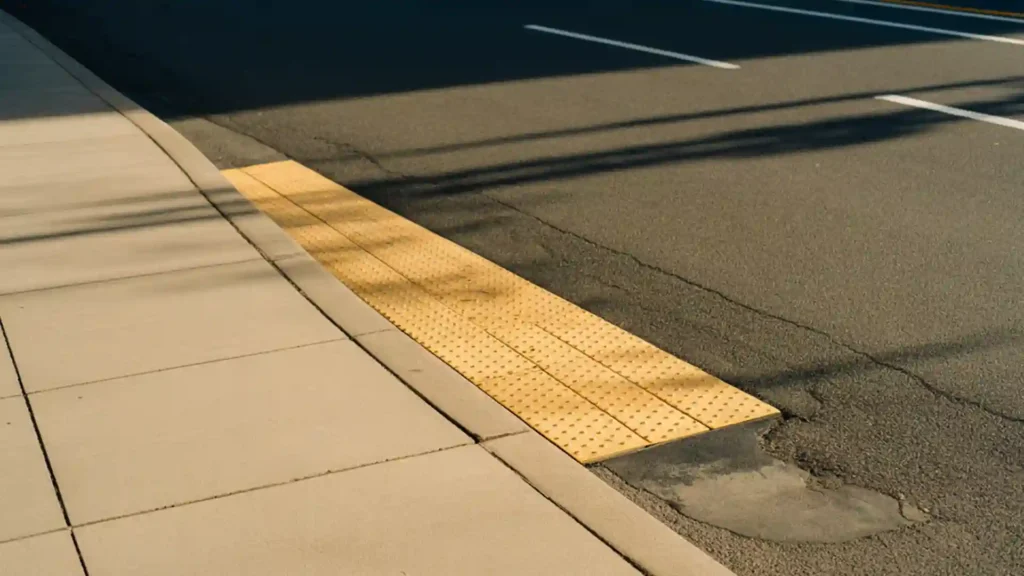
Sidewalk curb ramps are devices that provide a transition between a sidewalk and the street, and must follow these guidelines:
- Maximum slope: 8.33% (1:12 ratio)
- Landing at top and bottom: 36” minimum in length
- Flared sides for pedestrian safety
Curb ramps also change the direction of water flow along sidewalks and near driveways, so their correct installation is necessary to provide access according to the ADA, as well as appropriate stormwater management.
Durafy Pro Tip: When you’re having your sidewalk contractors install or re-do your curb ramps, make sure they include trench drains to avoid water pooling without sacrificing accessibility.
Detectable Warning Surfaces
Tactile indicators including truncated domes which are set at curb ramps and edges of sidewalks. According to the Indiana-based National Center on Accessibility, these surfaces:
- Shall provide a visual contrast with the surfaces of adjoining walkways
- 24 inches past the width of the ramp
- Detectable warnings help to inform sight-impaired pedestrians of street crossings and elevation changes, thereby promoting safety and navigation.
Durafy Pro Tip: Try vibrant, high-contrast colors near driveways to help pedestrians and cars both see one another.
Material and Surface Considerations
Choosing the right concrete mix and surface finish is critical for ADA compliance and long-term durability. According to ConcreteNetwork.com, slip-resistant textures, smooth trowel finishes, and proper curing help prevent accidents, especially near commercial entrances or driveways.
Durafy Pro Tip: Ask your sidewalk contractors about broom-finished or exposed-aggregate surfaces; they balance safety, aesthetics, and durability.
How Can Commercial Concrete Walkways Keep Pedestrians Safe?
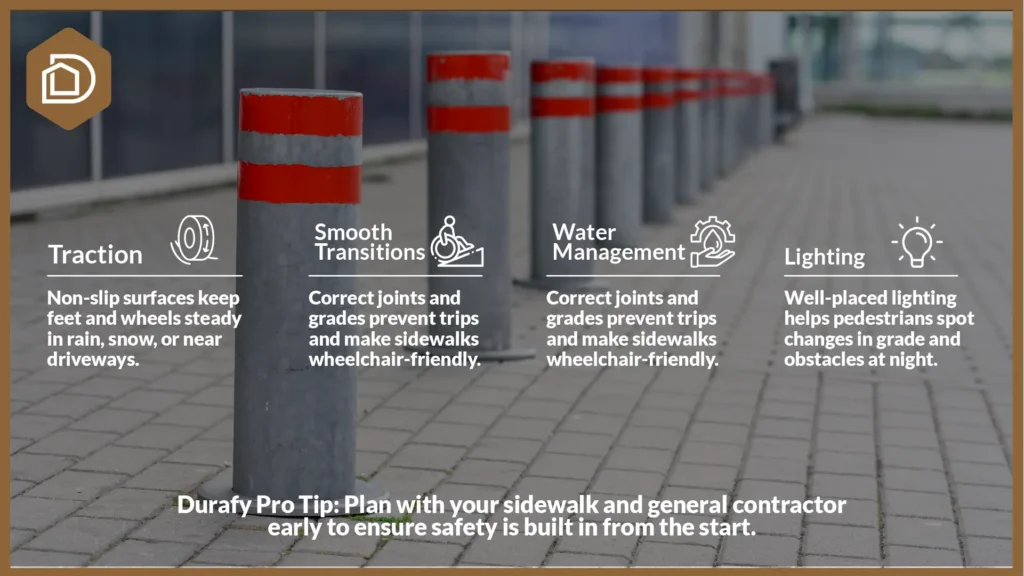
Pedestrian safety on commercial walkways isn’t just a regulatory box-checking issue; it’s about creating a place where people feel safe and confident to be, and welcome. Sidewalk safety, construction experts say, comes down to four things in particular: Traction, smooth transitions, water management and lighting.
- Traction: Non-slip finishes keep feet and wheels steady even in rain, snow or near ice-coated driveways.
- Easy transitions: If joints and grades are correct, there should be no awkward bumps to trip pedestrian or wheelchair traffic.
- Water management: Slopes, combined with a network of drains and scuppers, divert water from surfaces to prevent pooling that causes slips or concrete damage.
- Lighting: Properly placed lighting is key to helping pedestrians discern any changes in grade or potential obstacles in the dark.
All of these pieces work together to prevent accidents, shield business owners from liability, and enhance the longevity of your sidewalks. Collaborating with experienced sidewalk contractors and alongside your general contractor, this safety margin is engineered in from the start, rather than added on as an afterthought once it’s too late.
What Slip-Resistant Concrete Finishes Work Best for Commercial Walkways?
Picking the right concrete finish isn’t just about following the rules—it’s about creating walkways that feel safe and inviting. Sidewalk contractors often recommend textures like broom brushing, exposed aggregate, or patterned stamping, sometimes with anti-skid treatments. Each finish boosts traction, making wet or icy surfaces much safer for pedestrians and wheelchair users.
- A broom finish gives moderate texture, making it perfect for retail entrances or light pedestrian areas.
- Exposed aggregate provides a stronger grip, ideal for high-traffic zones, loading docks, or spots near driveways.
- Patterned stamping combines style with function, offering traction while enhancing the look of plazas, hotel entrances, or other public spaces.
Choosing the right finish is all about balancing safety, durability, maintenance, and how busy the walkway will be. What works in a quiet courtyard might not hold up in a bustling commercial loading area. That’s why having experienced sidewalk contractors and your general contractor involved from the start is essential.
Durafy Pro Tip: Test small sample areas of your chosen finish under wet conditions before committing to the full installation. This way you can be sure the walkway is safe, functional, and visually appealing.
How to Prevent Trip Hazards on Commercial Sidewalks?
- Garden sheds and tool storage buildings
- Outdoor kitchens and barbecues
- Swimming pool equipment and hot tub platforms
- Air conditioning units and standby generators
How much does a Concrete Pad cost in Charlotte NC vs a Concrete Slab?
Trip hazards typically arise from uneven slabs, settlement cracks, or improperly sealed control joints. Regularly installing well-spaced joints at 3- to 5-foot intervals accommodates thermal expansion and controls crack formation.
Leveling adjacent slabs to within 1/4 inch across joint lines and sealing perimeter joints with flexible sealant mitigates debris infiltration. Together, these practices maintain a flush walking surface and prevent abrupt height differentials that could lead to falls.
ADA Compliant Sidewalks – Install, Repair and Maintenance Charlotte
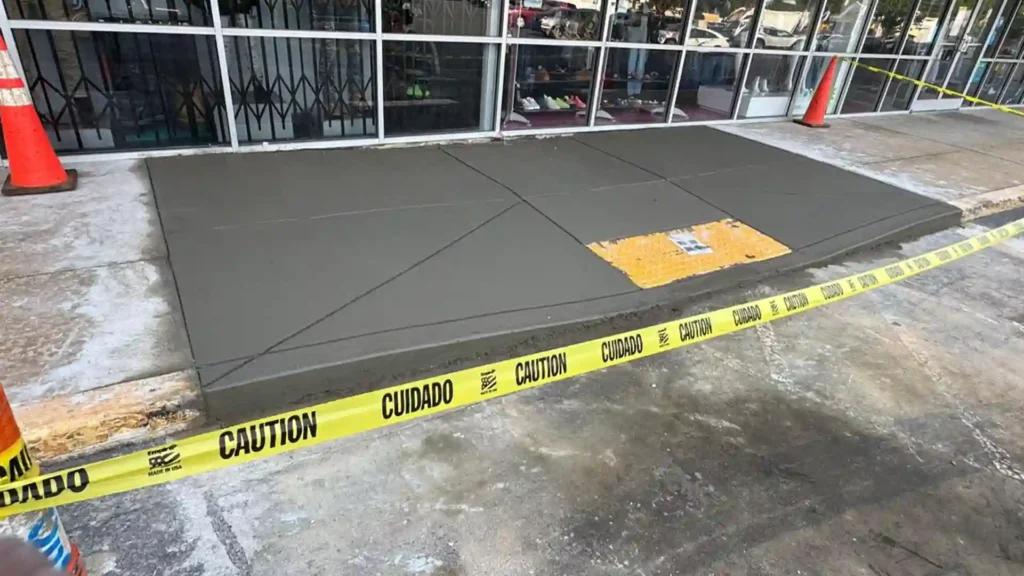
Constructing ADA-compliant sidewalks involves more than pouring concrete—it’s about safety, longevity and accessibility. Specialized sidewalk contractors and general contractors pay attention to every detail, even to driveway interfaces, ensuring everything is up to code and that pedestrians are safe.
Installation & Repair Workflow
- Site Survey: Document grades, utilities and potential driveway/parking conflicts.
- Construction Plan: ADA size, grade, drainage and slip-resistant finishes.
- Construction: Subbase preparation, formwork, reinforcements, finishings, and curing.
- Repairs & Resurfacing: Crack injection, patching, replacement of slabs or resurfacing to add up to 10 years life
Durafy Pro Tip: Do a “walkability audit” with your contractors before you pour concrete, so that you can catch slope or drainage issues early.
Inspection & Maintenance
- Inspect annually and after severe weather.
- Check surface texture, joints, slope, curb ramps, and detectable warnings.
- Address minor defects quickly to prevent bigger problems.
Durafy Pro Tip: Take photos when conducting inspections to have evidence of compliance to American Disabilities Act (ADA) code.
Understanding Costs for Commercial ADA Sidewalks
Commercial sidewalk projects involve labor, materials, permitting, grading, drainage, and ADA-specific features—all of which drive the final price. Material choice (standard vs. high-strength concrete), finish type, site accessibility, and ramp complexity influence estimates.
Budgeting upfront for drainage, lighting, expansion joints, and detectable warning surfaces prevents costly change orders and ensures durability. Knowing the cost empowers property owners to plan investments that balance safety, compliance, and long-term value.
How ADA Compliance Impacts Costs
ADA features add costs for:
- Extra concrete volume for wider paths and ramps
- Precision grading for slope compliance
- Detectable warning surfaces
- Specialized curb ramp forms
Integrating these requirements during initial construction avoids retrofits, which can be 20–30% more expensive than building right the first time. Experienced sidewalk contractors and your general contractor can optimize design and materials to control costs while maintaining full compliance.
Work Type | Price per Sq Ft | Notes |
New Installation | $8–$15 | Depends on concrete mix, reinforcement, and finish complexity |
Minor Repairs / Patching | $5 | Quick fixes for small cracks or surface wear |
Slab Replacement | $10–$12 | Includes demo, formwork, and finishing |
Decorative / Complex Ramps | $12–$15+ | Intricate curb ramps, exposed aggregate, or stamped finishes |
Durafy Pro Tip: When planning sidewalks near driveways or high-traffic commercial zones, consider high-strength concrete or broom/exposed-aggregate finishes to reduce long-term maintenance costs and liability.
FAQ's
The maximum running slope for an ADA sidewalk is 5% (1:20 ratio) and the maximum cross slope is 2% (1:50 ratio). Proper slope prevents wheelchair drift, reduces slip hazards, and ensures water drains correctly from sidewalks and nearby driveways.
ADA standards require a minimum clear width of 36 inches between vertical obstructions. This accommodates wheelchairs and pedestrians side by side. Wider sections near driveways or heavy foot traffic areas are recommended for added safety.
Effective finishes include broom finish, exposed aggregate, and patterned stamping. Broom finish is suited for light pedestrian areas, exposed aggregate for high-traffic zones or driveway interfaces, and patterned stamping blends safety with visual appeal. Testing finishes under wet conditions ensures real-world traction.
Professional inspections should occur at least once a year and after severe weather. Check slopes, surface texture, joints, curb ramps, and detectable warning surfaces. Addressing small defects early prevents accidents, maintains ADA compliance, and prolongs the sidewalk’s lifespan


